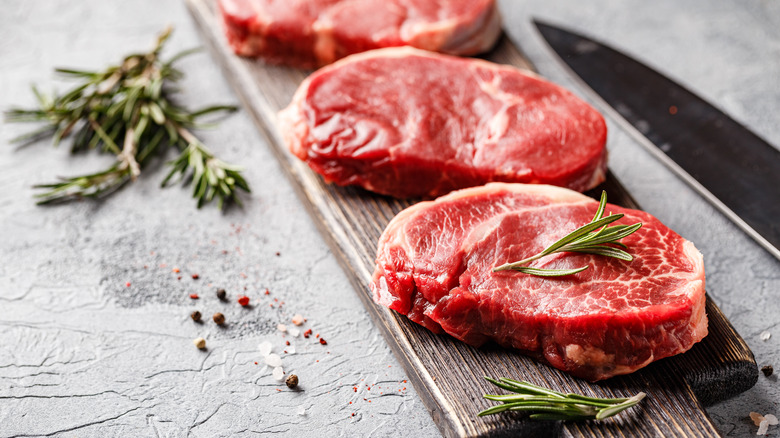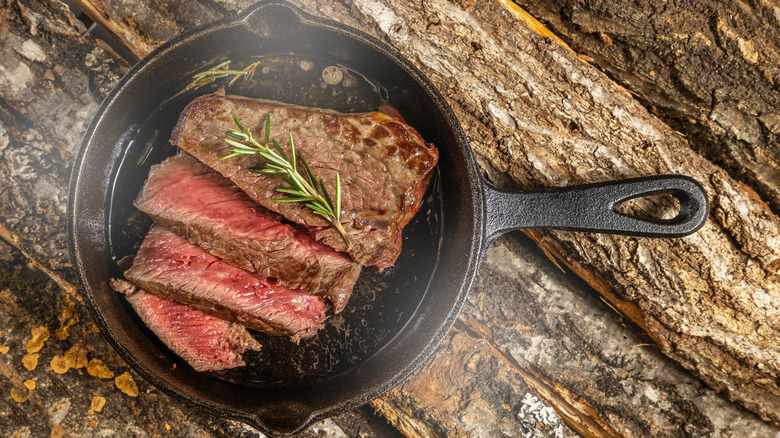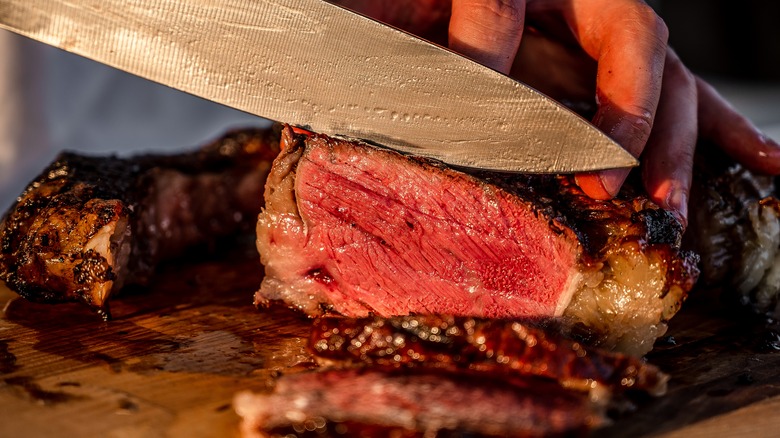Why You Shouldn't Oil The Pan When Making Steak
In the gastronomical cosmos, few things are simpler or more satisfying than a hot, juicy, beautifully marbled beef steak. Sirloin, ribeye, porterhouse, T-bone, tenderloin — each offers a different eating experience and a surprising level of culinary challenge, despite the fact that you're cooking a single ingredient in a single pan. Because for as many people who love steak, there are just as many ways to ruin it. And a poorly cooked steak is a culinary tragedy.
One such mistake is oiling the pan before adding the meat. But doesn't everyone do just that? In countless recipes, you bring your oil up to temperature before adding the other ingredients. But instead, you should add it to the steak itself before putting it in your skillet. In a pan, olive oil is just fine — but in a ripping-hot cast-iron skillet, you'll want an oil with a high smoke point, such as avocado or canola oil, says Webstaurant Store. Flavorful ghee and beef tallow also have decent smoke points, according to a chart on Masterclass — but butter is low on the list, and it may burn.
Regardless of the fat used, you'll thank us later when you oil your steak instead of the pan.
Where there's smoke, there's splatter
You've likely experienced what happens when meaty ingredients hit hot oil: a big, potentially hazardous mess. That's due to moisture on the steak vaporizing in the hot oil. Water can't combine with the oil but does have to go somewhere, according to (sustainable) palm oil purveyors Frymax — and that somewhere is onto your countertop and possibly onto your skin. Oiling the steak and not the pan takes some of the danger out of cooking.
An oily pan is also a smoky pan, and all that smoke — science says — rises up, hits the ceiling, and keeps on going. It will find your upholstery, your clothing, all the overlooked recesses of your living space — until the whole place smells like whatever you're cooking, which is awesome for your family to come home to, perhaps, but decidedly not cute after a few days.
Without preventative measures, post-cooking aromas may demand a rigorous process to restore the balance, according to Apartment Therapy. Steak is great, but burnt meat-scented towels? Not so much.
Fat where you want it
Another reason not to oil the pan before making steak is that anything swimming in oil will inevitably soak up that oil. This adds a ton of fat to the finished product, which is not ideal when you're trying to eat lean, or if you want the natural steak flavor to come through and not the taste of the oil. (Nobody wants a greasy piece of dry-aged Wagyu.) There should be just enough fat to sear your steak — let the heat conducted by your pan cook it to your desired doneness.
If you lovingly lather your steak in cooking fat, you'll ensure it gets an even coating and, as a result, an even cooking. As much as cast-iron cookware loves oil, you're trying to cook a steak dinner here. (You can season your pan later.) Rub your steak with your fat or oil of choice and then cook it, and don't forget to let it rest after so that it retains its juiciness, unleashing all that goodness only when you're ready to eat it.
Steak School cautions that cutting a steak before it's had time to rest essentially undoes all your hard work over the hot stove. When it comes to pursuing the gustatory perfection of a masterfully executed steak, no detail should be overlooked.


